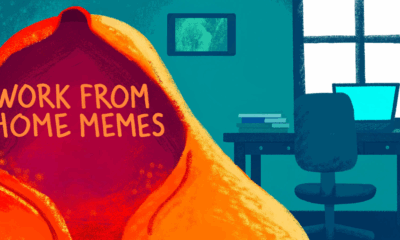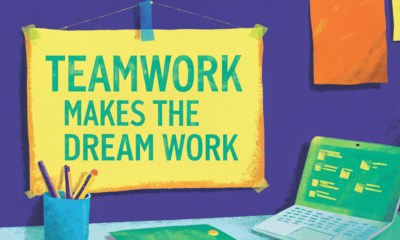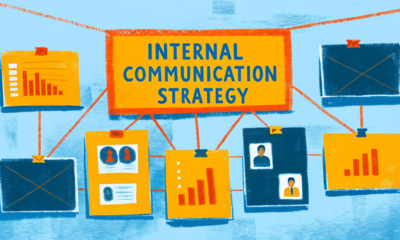Talent and Hiring
How to Win the Talent War with Employer Branding

In today’s job market, a truly exceptional candidate feels less like a prospect — and more like a rare find every company is racing to secure.
You’re not just filling roles. You’re chasing something rare, something powerful. The kind of person who can transform a team, bring clarity to chaos, or lead through uncertainty. And just like a priceless artifact, these candidates don’t stay unclaimed for long.
The challenge? There simply aren’t that many of them. Not due to people lacking ambition — but because the new world rewards breadth, not depth. Today’s professionals switch between titles, side businesses, and shifting goals. They acquire quickly but seldom invest the time it takes to master a single set of skills. For companies that are truly seeking greatness, this creates a high-stakes game: a silent but vicious talent war brewing in every industry.
Everyone’s competing for the same limited number of high-leverage people. And in this kind of war, traditional recruiting tactics are not good enough. What succeeds is clarity, purpose, and perception.
What succeeds is a powerful employer brand.
The numbers confirm it. About 75% of applicants look at your employer brand prior to applying. Most companies, however, can’t clearly communicate their employer value proposition — the story that establishes why an individual would work for you. That disparity doesn’t hurt recruiting alone. It corrodes trust way prior to the first interview.
In this post, we’ll explore how to build a standout employer brand that draws and retains best-in-class talent. You’ll learn how to hone your EVP, use storytelling as a competitive advantage, avoid red flags quietly destroying your reputation, and make candidates not just apply — but pledge.
Because in the current market, the question isn’t “Are we hiring?”
It’s “Why would they choose us?”
Why employer branding is your strategic advantage today
Employer branding is more than catchphrases or logos. It’s the entire image of what it truly feels like to work at your company — from your mission and core values to the moment-to-moment experiences workers have every day. Put simply, it’s your employment reputation — how job candidates, current employees, and even alumni think about and talk about you.
But these days, this reputation is no longer private. Radical transparency has made workplace culture open season. Sites like Glassdoor, social media streams, and professional networks provide a glimpse into your company’s authentic nature — and this glimpse can’t be avoided. Those who have researches company culture are aware it is not a distinct concept, but the pulse of your employer brand. Culture forms experience, and that experience, in turn, constructs your brand reputation.
It’s also important to look at the profound shift in workforce demographics and expectations. Millennials and Gen Z, now comprising the majority of the workforce, are not looking for just jobs — they’re looking for workplaces where they can live their values around diversity, equity, inclusion, and well-being. They’re looking for authenticity and purpose, not perks.
At the same time, global competition for talent is mounting. This puts employer branding on the wish list and onto the must-have business agenda. Authentic, powerful employer brands with a good reputation win tangible benefits: faster hiring, lower turnover, and employees who truly own the company purpose.
Here’s the hard data that any HR leader can’t ignore:
- Almost 86% of applicants check company reviews and employer reputation prior to application. Neglecting your brand perception is no longer a choice.
- However, only approximately 12% of employees firmly feel that their employer’s value proposition strongly communicates what is special and interesting about their work environment. This expectation-reality gap breeds distrust and disengagement.
- Companies that have well-defined, authentic employer brands don’t just receive more applications, but better applications — more suitable candidates who have an affinity with the culture and values of the company. And such a fit is statistically confirmed to reduce turnover by up to 28%.
- An effective employer brand can reduce cost-per-hire by up to 50% and enhance employee retention by 28%, latest industry reports indicate.
The takeaway? Employer branding is no longer a branding exercise. It’s a strategic imperative that directly drives your bottom line and organizational resilience.
For talent marketers and HR leaders, that means putting authentic, lived experiences and differentiated, clear messaging first. When your employer brand is the mirror reflection of life inside your company, it’s a magnet for the right talent — not just a billboard for the masses.
Who really shapes the employer brand?
It’s tempting to assume that employer branding is an HR function or something that can be managed by a behind-the-scenes marketing group. But the reality is, your employer brand isn’t a campaign — it’s a living reputation, founded on what people see, hear, and experience in their day-to-day interactions with your organization.
And that includes everyone, whether they mean to or not.
Let’s dive in.
- People managers shape the brand through daily leadership, communication, and how they show up in moments that matter — like performance reviews, onboarding, or difficult conversations. Their consistency (or lack of it) influences employee trust more than any slogan ever could.
- Employees define the brand by what they write on social media, what they say to their friends, and what they don’t say anything about. Every message, Glassdoor review, and LinkedIn post is a signal of the employee experience.
- Executives carry significant weight. When leadership is explicit in communicating purpose — and follows through on it — they send a message of alignment. But when there is dissonance between what leaders say and what employees experience, the employer brand begins to unravel.
- Candidates also shape the brand. The hiring process — how promptly you respond, how clearly you communicate, how humane your interviews are — leaves a lasting impression, whether or not the individual is hired.
Customers and clients play a subtle but growing role, too. As brand reputation and employee experience become ever more entwined, how your people are treated internally can influence how your company is treated externally.
How this plays out differs depending on the size and structure of your organization.
- At a startup, the founder is typically the loudest voice of the brand — through vision, values, and how early employees are treated. There is no employer branding strategy, per se, but culture is present in every touchpoint.
- In mid-sized businesses, employer branding typically sits between HR, marketing, and leadership. In this case, the challenge is a question of consistency — getting messaging, employee experience, and EVP to all line up across teams and geographies.
- In large enterprises, it is not uncommon to find dedicated employer branding teams, in-house specialists, or even external employer branding agencies. These teams work to create positioning, maintain brand health, and maximize the brand message globally. Yet even in these instances, the brand is only as good as its local managers and the daily experience that they provide.
The most powerful employer branding programs recognize this co-ownership. HR and talent executives can be architects, designing EVP frameworks and informing narrative — but the implementation itself lives in culture, in operations, and in the behaviors of people at every level.
When your EVP reflects the reality of the employee experience, brand trust grows — naturally and sustainably.
Because no matter how sophisticated your strategy, your employer brand will always communicate one thing: what people actually feel like working for you.
Why authentic employer branding always wins
The best candidates don’t send a stack of résumés via email. They don’t need to. Usually, they’re already working — chaotic, busy, and distracted only by the things that catch them for the right reasons.
That “something” isn’t always a title or a paycheck. More often, it’s a feeling. A sense that a company gets it — whether that means clarity of mission, respect for people’s time, or just the absence of empty talk.
This is where employer branding starts to do the real work. Not as advertising, but as atmosphere.
A strong employer brand doesn’t just say “We’re a great place to work.”
It quietly tells things like:
- “This is a team that has direction.”
- “This culture isn’t seeking to impress — it’s seeking to get it right.”
- “People here don’t just stick around. They grow, they question, they matter.”
And that kind of signal is what gets passed on. Well before you ever post a role, your potential applicants already have some idea on some instinctual level who you are — based on the way your team speaks, what your messaging communicates, how leadership looks, and how it all generally feels cohesive.
When that cue is low — when the career site looks great but the reviews tell a different story — top talent gets the message immediately. They don’t complain. They simply pass.
But when there is coherence — when values don’t show up in branding decks, but in decisions, in dialogue, and in the tone of voice of people — something breaks. Candidates are paying attention. Not because they’re in awe, but because something about your brand isn’t noise so much as a place where good work can happen.
You don’t need to be perfect. You just need to be readable.
Because where there is a world filled with over-promising and quick exits, clarity is attractive.
Using storytelling to bring your employer brand to life
People don’t connect to bullet points. They connect to moments — with things that feel as unvarnished, lived-in, true. That’s what narrative brings to employer branding. Not gloss, not slogan. Emotional texture.
When the individual scrolls through your job ad or finds themselves on your “About” page, they’re not looking for benefits. They’re looking for evidence — something that tells them what it’s like to be there. Not hypothetically, but practically.
And this is where most brands go wrong. They talk about culture but do not demonstrate it. They fill space with such statements as “we believe in growth” or “we celebrate diversity,” but leave out the specificity in which someone lived that moment. For actual culture lives in stories — like the junior who went against procedure and was heard, or the crew who owned up to a public mistake and fixed it together without finger-pointing.
When you’re presenting these stories, they don’t have to be perfect. They shouldn’t be, in fact. Effortful, tense, and learning stories are more interesting than the shiny highlight reels. It’s not that they must be specific, in real people, and presented without attempting to be something that they’re not.
Storytelling works not because it’s glamorous, but because it takes the intangible and makes it tangible. It gives candidates something to believe in — or disbelieve in — before they ever send in an application. It aligns your outer message with your inner truth.
And here’s the thing that not many employer brands get: your candidates don’t care to hear your spin. They want to hear someone else say it — someone who shows up in the room when no one else is watching.
Because before candidates ever are going to believe in your mission, they must first believe your people.
Red flags talent notices before you do
Sometimes, the problem isn’t a weak employer brand — it’s a loud mismatch between what’s said and what’s done. Candidates can feel it instantly, even if no one inside the company notices. That’s because employer branding is no longer shaped by HR campaigns alone. It lives in job listings, interviews, online reviews, and even silence.
When the experience doesn’t match the message, trust fades. And once that trust is gone, it’s almost impossible to recover.
Here are some of the most common red flags that quietly push talent away — and why they matter more than you might think:
“We’re like a family.”
To many candidates, this doesn’t sound warm — it sounds like code for blurred boundaries, emotional pressure, or unpaid overtime. If your culture relies on closeness, show how that actually works in practice, without leaning on clichés.
No salary range in the job description.
Candidates interpret this as a lack of transparency, or worse — a setup for lowballing. In 2025, people expect at least a range. When compensation feels hidden, the brand starts off in a cloud of doubt.
Endless interview stages.
Three rounds is often the limit for experienced talent. When candidates are asked to meet six people across two weeks — with little feedback in between — they assume the company lacks clarity or respect for time. Decision-making starts to feel chaotic.
Test tasks that resemble unpaid work.
Asking for a thoughtful sample is fair. Asking someone to create a full strategy, write a week’s worth of content, or solve a business problem for free signals exploitation. When there’s no feedback or follow-up, the brand suffers more than you think.
Strange or invasive interview questions.
Candidates notice when they’re asked personal questions with no clear link to the role. It signals poor training, bias, or a culture that lacks boundaries. Even one off-script moment can undermine everything else you’ve built.
The role that’s always open.
When a company repeatedly posts the same job over months, people notice. They wonder what’s wrong — high turnover, a toxic manager, a broken process? The longer the listing stays live, the more damage it does.
Over-sell during the interview.
When interviews feel like a sales pitch — all mission and enthusiasm, no substance — trust evaporates. Talented candidates don’t want to be sold. They want an honest conversation about fit, goals, and growth.
“We need someone fully dedicated to our mission.”
This may sound inspiring on paper. But when paired with low pay, vague expectations, or an “always on” culture, it quickly turns into a warning. Candidates hear: we expect you to sacrifice personal life for branding.
Ignoring reviews or public feedback.
Silence is a signal. If people are talking about your company online — good or bad — and there’s no thoughtful response, candidates assume you’re either unaware or unwilling to engage. Neither inspires confidence.
Generic, one-size-fits-all EVP statements.
Phrases like “We value innovation and collaboration” appear in thousands of career pages. If your message could be copy-pasted into any competitor’s site, it doesn’t differentiate you — it dilutes you.
Each of these signals, on its own, might seem minor. But together, they form a picture. And that picture tells candidates whether your brand is real — or just another story with nice fonts and the wrong intentions.
The good news? These aren’t branding problems. They’re operational ones — and that means they can be fixed.
But only if someone’s willing to look closely, listen carefully, and act with honesty.
Because in employer branding, silence and inconsistency speak louder than any tagline ever could.
Final thought: Employer branding as your organization’s genuine reflection
An employer brand isn’t the polished headline on your careers page.
It’s not the tagline that took six weeks and four agencies to approve.
And it’s never just the content you post — no matter how sharp the video or how catchy the language.
Your employer brand is the echo.
It’s what people say about working for you when no one from your company is in the room.
It lives in the quiet comments at industry events. In the tone of a former employee’s forum post. In how candidates describe the interview process to friends. It’s written between the lines of every exit conversation, every internal chat, every first impression that sticks.
It’s not about being perfect. It’s about being believable.
Because when a brand feels too manicured — too curated — people stop trusting it.
The real strength of your brand is how aligned it is with lived experience:
- It’s whether your leadership actually believes the mission they post about on LinkedIn.
- It’s how your team looks at 6:30 PM after a full day — energized or drained.
- It’s whether people feel proud to say where they work, even when no one asks them to.
- It’s whether your values are applied in the tough moments, not just printed on office walls.
- It’s how someone feels on a random Tuesday — not just during onboarding.
So yes, branding strategy matters. So do positioning, messaging, EVP frameworks. But they only work when the substance underneath is real. Because the best candidates can always tell when something’s off. And once they feel it, no amount of design or spin can win them back.
And if you need a clear place to start — here’s what to focus on next:
Not just to sound like an employer of choice — but to actually become one:
- Revisit your EVP.
Ensure it reflects the real employee experience today — and the direction you’re committed to tomorrow. - Walk the candidate journey.
Step into it as an outsider. Is it respectful, clear, human? Or are there silent drop-off points? - Equip your managers.
They’re the face of your employer brand, whether they realize it or not. Give them tools, language, and clarity. - Make culture visible — without gloss.
Use real stories, not highlight reels. Show moments of effort, learning, vulnerability, and care. - Treat feedback like strategy.
Exit interviews, reviews, even uncomfortable Glassdoor posts — these are insights, not threats. Use them.
Because at the end of the day, employer branding isn’t about attracting everyone.
It’s about helping the right people recognize you — and believe you’re worth showing up for.
Every single morning.
Talent and Hiring
Skills-Based Hiring in the AI Era: How Modern Recruiters Find Talent Beyond Degrees

The world of hiring isn’t just changing – it’s being rebuilt.
In the past, a diploma and a job title defined a candidate’s value. Today, a short online course, a GitHub portfolio, or a verified badge can open doors that once required many years of formal education. Skills-based hiring is no longer the future – it’s already a reality.
This shift is supported by statistics: according to LinkedIn’s The Future of Recruiting 2024 report, 73% of talent acquisition professionals now prioritize skills over diplomas. But behind this lies more than just a new trend – it’s a rethinking of what truly matters in a candidate.
Modern recruiters increasingly use analytics tools and artificial intelligence to evaluate a person’s potential through “skill signals” and data patterns. Diplomas and degrees are losing their significance – flexibility, proven abilities, and adaptability have become the new currency in hiring.
However, with these capabilities come new questions: how do algorithms influence who gets noticed, and how can human judgment coexist with machine logic in talent acquisition?
As we enter the era of skills- and AI-based recruiting, we are faced with the need to rethink our approach to hiring – and to ask what is truly valued in a person.
What is skills-based hiring?
Skills-based hiring is a modern approach to recruiting that prioritizes a candidate’s actual abilities over formal education. Instead of asking, “Where did you study?”, recruiters now ask, “What can you actually do?” This may seem like a small change, but it fundamentally shifts how organizations assess talent and potential.
This approach covers both hard skills – such as programming, writing, or data analysis – and soft skills, like communication, leadership, and adaptability. The balance depends on the role, but the principle remains the same: the ability to solve real problems matters more than a formal degree.
It opens the door to a wider talent pool, valuing experience, curiosity, and problem-solving over credentials. It also helps reduce discrimination based on where someone went to school and curbs favoritism – giving opportunities to those who can truly perform the job, not just those who attended the “right college” or happened to sit next to a manager in class.
Many companies are implementing data-driven evaluation programs that assess demonstrated competencies, practical experience, and verified achievements. This approach addresses the growing gap between the rapid pace of industry change and the slower adaptation of traditional education.
Recruiters have noticed that great candidates are often overlooked if they don’t meet “official” criteria. Data backs this up – according to TestGorilla’s State of Skills-Based Hiring 2025 report, about 85% of employers now use this method to some extent, and more than half apply it regularly.
Modern hiring, supported by AI, allows recruiters to accurately identify and measure candidates’ skills. This enables them to focus on people’s real strengths rather than labels, making the process fairer, more effective, and aligned with what truly matters in the workplace.
Why traditional hiring methods no longer work?
Now that we understand what lies behind skills-based hiring, it’s time to look at why this approach is eclipsing traditional recruitment.
For decades, hiring relied on a simple formula – a college degree plus a few years of experience equaled competence. But that equation no longer holds. Today, only about 36% of U.S. adults and 30.9% of Europeans hold a college degree, and many of these graduates end up working outside their field of study. This mismatch highlights a growing gap between what formal education provides and the practical skills employers now require.
As a result, recruiters often find themselves with empty pipelines and unfilled roles. It’s not that talent doesn’t exist – it’s that the system overlooks candidates who have built real-world skills, learned across multiple disciplines, or developed portfolios through self-directed projects.
Skills-based hiring flips that model. Rather than assuming competence from credentials, it measures performance directly – through structured assessments, task-based evaluations, and verified experience. It expands the talent pool, reduces bias, and values adaptability – a critical strength in a world where, according to the World Economic Forum report, nearly 39% of current skills will become obsolete by 2030.
Traditional vs. Skills-based hiring: A quick comparison
| Aspect | Traditional hiring | Skills-based hiring |
|---|---|---|
| Main focus | Degrees, job titles, years of experience | Verified skills, performance, adaptability |
| Talent pool | Limited to candidates with formal education | Open to diverse, self-taught, and cross-functional talent |
| Evaluation method | Resume screening and interviews | Practical assessments, data-driven evaluations |
| Outcome | Predictable but narrow candidate selection | Broader, more dynamic workforce potential |
Traditional hiring rewarded predictability. Skills-based hiring rewards potential, and that shift is redefining what “qualified” truly means in modern recruitment.
Benefits of AI in skills-based hiring
As traditional hiring models began to falter, AI recruitment tools didn’t just automate the process – they reimagined the entire structure. In the era of skills-based hiring, AI acts as both an accelerator and an equalizer, helping recruiters see talent as it truly is: through abilities, not degrees. This transformation is reshaping talent acquisition strategies and enabling more diversity in hiring.
AI can thoroughly assess a candidate’s specialized skills, interacting with them at the level of a professional familiar with the day-to-day tasks and competencies required on the job. This benefits both candidates, who no longer need to “fake it” to pass an interview, and recruiters, who don’t have to memorize every process for every role.
Smarter candidate search and selection
In the past, recruiters spent hours scanning resumes for the right keywords. Now, AI analyzes profiles, matches skills to job requirements, and highlights candidates who might otherwise be overlooked. In 2025, around 65% of employers used AI in hiring: 59% for resume screening and 51% for candidate sourcing. This allows recruiters to move quickly from searching to shortlisting and uncovering hidden talent.
Moving beyond degree requirements
AI and skills-based assessments are gradually replacing rigid degree requirements. Over half of U.S. employers have removed college degree requirements from job postings. This opens the door to a broader talent pool – people with practical experience, online courses, certifications, and real-world projects rather than just formal education. The result is a more inclusive and diverse hiring landscape.
A higher level of skills accuracy
AI platforms test what truly matters on the job: professional tasks, soft skills, and cognitive abilities. About 69% of employers use soft skills tests, and half assess cognitive abilities. This gives recruiters a deeper understanding of how candidates think, collaborate, and solve problems – far beyond what traditional interviews can reveal.
Smarter hiring decisions through AI analytics
AI doesn’t just automate routine steps – it enhances judgment. Candidate ranking, interview scheduling, and performance evaluation are now faster and more precise. In some companies, time-to-hire has been reduced by up to 70%, and 94% of employers report significant improvements in hiring outcomes.
Consistency and scalability without losing quality
As organizations grow or hiring volumes surge, maintaining consistent evaluation standards can be challenging. AI structures the process and ensures it remains regular. About 76% of companies now use structured skills or cognitive assessments, guaranteeing each candidate is evaluated against the same criteria. This consistency allows companies to scale hiring efficiently while maintaining fairness, quality, and inclusivity.
In the end, AI doesn’t replace recruiters – it empowers them. It lets them focus on the human aspects of hiring: in-depth interviews, assessing cultural fit, and making final decisions, using AI analysis as a reliable foundation. It speeds up processes, increases accuracy, reduces bias, and helps organizations identify real talent.
Challenges and ethical questions of AI-driven hiring
AI may be transforming recruitment, but even progress comes with friction. The more we trust algorithms to identify talent, the more we need to question what those algorithms are actually learning from. They mirror the data we feed them, and when that data reflects years of biased hiring decisions, the results can quietly repeat those same patterns. Gender, ethnicity, age, and even subtle linguistic cues can unintentionally shape how “qualified” someone appears to a machine.
A 2024 study from the University of Washington found significant racial and gender biases in how large language models ranked resumes. The research revealed that AI tools favored white-associated names 85% of the time and male-associated names 52% of the time, while female-associated names were favored only 11% of the time. Notably, the models never preferred Black male-associated names over white male-associated names.
Then there’s the question of transparency. Candidates increasingly want to know how their applications are evaluated, what factors influence scoring, and whether they’re being compared fairly. Yet many AI tools still operate like black boxes – efficient but opaque. In a hiring environment built on trust, that opacity can erode confidence and harm employer reputation just as quickly as it builds efficiency.
And while automation streamlines the search, it also risks dulling the human touch that defines great hiring. Empathy, intuition, and context still matter – perhaps more than ever. Recruiters who use AI as a partner rather than a replacement are finding the right balance: letting data inform, but not dictate, their decisions. Because in the end, the future of hiring shouldn’t just be smarter – it should be fairer, more transparent, and deeply human.
Conclusion: embracing the future without losing the human touch
AI has reshaped hiring in ways we couldn’t have imagined, streamlining processes, uncovering hidden talent, and making skills-based evaluation the new standard. The convenience is undeniable, but it also reminds us that recruitment is more than data points and algorithms. Behind every skill signal is a person with ambition, creativity, and potential that no machine can fully capture.
Skills-based hiring takes this a step further. By focusing on abilities, performance, and adaptability rather than just degrees or past titles, organizations can identify candidates who are truly equipped to succeed in their roles. This approach not only improves fairness and inclusivity but also ensures that talent is evaluated on what really matters: the skills and potential that drive results.
The future of hiring isn’t about going back to old methods. It’s about finding balance – letting AI handle the mechanics while humans focus on empathy, fairness, and growth. Recruiters are no longer gatekeepers but interpreters, translating insights into meaningful decisions.
Organizations that master this partnership – where technology empowers, not replaces, human judgment – will build workforces that are not just skilled, but adaptable, engaged, and ready for whatever comes next. In this evolving landscape, embracing AI doesn’t mean losing the human touch. It means using it wisely to see talent in its fullest form.
Talent and Hiring
The Quiet Power of Internal Mobility: Retain by Hiring From Within

A new role opens up in your company.
The search begins — résumés flood in, recruiters sharpen their instincts, and the quiet battle for “the right talent” is on. One candidate’s skills don’t quite measure up. Another seems promising until your gut whispers, “This one might be a culture grenade.” A third is perfect on paper, but you can already see them wilting in the role like a flower in the desert.
Then, you look up. Maybe you glance across your office, or — if your “office” lives inside a company chat — you scroll through your team list. And there it is: a name you’ve known for years. Someone who’s quietly outgrown their current role, or recently revealed a whole new skill set on a high-stakes project. Suddenly, the question changes:
Do you keep fishing in the endless ocean of unknown candidates?
Or do you set your sights on your own harbor — a place where people know each other, understand the processes, and won’t need months of adaptation (with the very real risk of bringing in a hidden toxic disruptor)?
Sure, hiring from within comes with its own set of considerations. You may have to manage team dynamics or fill a backfill role. But if you’ve built a team of remarkable professionals, wouldn’t you want to keep them? Internal hiring not only keeps your best people close — it lets them bloom in ways that benefit the whole organization.
And that’s exactly what we’ll explore here: why internal mobility is an underused strategic advantage, how it compares to external recruitment, and the practical steps to build a culture where your next star hire never has to leave the building to grow.
What is internal mobility?
Internal mobility is the intentional practice of shifting employees into new roles, projects, or responsibilities without leaving the organization. This includes promotions, lateral transfers, cross-department moves, job rotations, or short-term project assignments.
This сareer movement comes in different forms:
- Horizontal moves — moving to a different team or function at a similar level, gaining fresh skills and perspectives without a formal promotion.
- Vertical moves — promotions that recognize growth and expanded responsibilities, rewarding dedication with advancement.
With ongoing talent shortages, rising recruitment expenses, and longer onboarding times, internal career growth becomes a key solution. It leverages a pool of employees already familiar with your company’s culture and workflows. Recent findings show that companies with high internal mobility see employees staying 53% longer, highlighting how growth opportunities boost both retention and long-term loyalty.
For example, consider a marketing analyst who has unofficially taken on project leadership — managing deadlines, coordinating teams, and representing the company’s voice. An external hire would need months to catch up to this level of insight. By fostering talent from within, organizations not only reward dedication but also retain invaluable institutional knowledge and cut hiring expenses.
Internal mobility isn’t about stagnation or fearing outsiders. It’s a commitment to transparency, respect, and gratitude for the people who’ve delivered results year after year — giving them the space and opportunity to realize their full potential.
So here’s a question for leaders: Could your next star performer already be on your payroll?
Why internal mobility matters now
If internal mobility is the engine, today’s market conditions are the fuel. Employees today aren’t simply chasing bigger paychecks — they’re chasing growth, stability, and purpose. But there’s a catch: scroll through LinkedIn or TikTok, and you’ll see career coaches telling people to switch jobs every year to climb the ladder faster and earn more.
If you want to keep your top performers from following that advice, you have to beat it at its own game. That means offering visible, tangible growth opportunities inside your walls — proving that the fastest way up doesn’t always require walking out the door.
Why is internal career growth a winning strategy today? Because it:
- Retains institutional knowledge instead of rebuilding from zero.
- Speeds up onboarding since employees already know the culture and systems.
- Cuts recruitment costs and shortens hiring timelines.
- Boosts engagement by offering clear advancement opportunities.
- Strengthens company culture by showing growth is valued and rewarded.
In a market this competitive, your best strategy might not be chasing the next “perfect hire” — it’s making sure your current talent sees a future worth staying for.
Internal vs. external recruitment: a strategic comparison
In other words, before you start scanning the market for fresh faces, it’s worth asking: how does growing your own talent really compare to bringing in someone new? The truth is, both have their strengths — but the balance between them can make or break your hiring strategy. So, let’s lay it out side by side and see where internal moves outshine external hires (and where the opposite might be true).
| Factor | Internal Recruitment | External Recruitment |
|---|---|---|
| Time to Fill | Shorter — candidates already know the company, processes, and culture. | Longer — sourcing, screening, and onboarding take more time. |
| Cost | Lower — minimal advertising, reduced onboarding costs. | Higher — advertising, agency fees, and training expenses add up. |
| Cultural Fit | High — employee already aligned with company values. | Variable — cultural fit is harder to assess before hiring. |
| Skill Ramp-Up | Faster — familiarity with tools, workflows, and stakeholders. | Slower — new hire needs to learn company-specific systems. |
| Retention Rates | Typically higher — promotion boosts loyalty and engagement. | Variable — new hires may leave if role or culture isn’t what they expected. |
| Diversity Potential | Strengthens internal diversity pipeline when applied inclusively. | Can bring in fresh perspectives and backgrounds. |
| Innovation Potential | Builds on existing institutional knowledge. | Can inject new ideas and approaches. |
Takeaway: External hiring will always have its place, especially for niche skills or market expansion. But internal recruitment often delivers faster results, lower costs, and stronger cultural alignment — making it a strategic first step before looking outward.
The roadblocks to internal hiring
If internal hiring is such a smart move, then why hasn’t it become the “default” yet? It’s simple — there’s a whole set of barriers, not only technical but purely human as well.
- First of all, there’s invisibility. Internal job openings sometimes sit buried somewhere deep in the corners of an old portal or get sent out in a mailing “for the chosen few.” And if no one has heard about the role — how can an employee even realize they can apply for it?
- Next comes manager resistance. Imagine: in your team, there’s someone who handles tasks for three people, and does it with a smile. Of course, the thought that they might be “taken away” to another department triggers a nervous tic. You’d have to redistribute responsibilities, rebuild processes — and what if everything collapses? It’s easier to keep the person in place, even if they’re already sitting there like a bird in a cage, only dreaming of spreading their wings.
- There’s also the matter of employee initiative. Not everyone will rush forward shouting, “Pick me!” — especially if they have self-doubt, a habit of keeping their head down, or the simple feeling of “I’m already overloaded.” A couple of honest conversations can help, but it’s important not to confuse motivation with pressure.
- And now to the favorite topic of office legends — favoritism. Even if a person has truly earned a promotion, there will always be those who decide it’s “friendship with the boss.” And some people believe this themselves because of impostor syndrome: “Me? In this role? Everyone will think it’s just an accident!”
- Let’s add the fear of investing in training. Managers might think: “We’ll invest resources now, and in six months they’ll leave for a competitor offering 20% more salary and a free gym membership.”
- And of course, the “fresh blood” effect. There’s a belief that a newcomer will always bring new ideas, while those who have been in the company for a long time have “lost perspective.” Although, to be honest, fresh ideas can also come from within — the main thing is to create a place for them to grow.
By understanding exactly what slows down internal mobility, you can start dismantling these barriers — and turn career movement inside the company from a rarity into the norm.
Building visible growth paths
Turning internal mobility from a nice theory into something people actually experience every day means making career growth impossible to miss — and easy to talk about. If your employees can’t see their next step, or worse, feel like there isn’t one, they’ll start imagining it somewhere else. So how do you make the path obvious?
1. Internal job postings people actually notice
Skip the forgotten corner of the intranet. Post openings where people already are — shared channels, team announcements, even short video intros from hiring managers. Keep the listings clear, accessible, and updated. Better yet, add filters by skills, growth potential, and career track so employees can instantly see where they fit. If the opportunity is hidden, it might as well not exist.
2. A living talent map, not just a static directory
Think of it like an internal LinkedIn, but built around your company’s reality. Map out who has what skills, who’s looking to stretch into new areas, and what roles or projects are available. AI or even a simple matching tool can connect the dots automatically, surfacing opportunities before people even think to ask.
3. Rotations that feel like growth, not disruption
You don’t need to be a giant corporation to run job rotations. A few weeks in another department can spark new ideas, teach new skills, and build empathy across teams. Pair that with cross-functional talent reviews so leaders know who’s ready for a move — ideally before they start browsing LinkedIn during lunch.
4. Career conversations baked into performance reviews
A review shouldn’t feel like a verdict. It should feel like a roadmap. Ask questions like: Where do you want to go next? What would make you excited to stay? What do you need to get there? Reward managers not for hoarding talent, but for helping people grow out of their current role — and into their next one within the company.
Make career growth visible, make it loud, and make it something people can actually picture for themselves. When the next opportunity feels close enough to reach, your best talent won’t go looking somewhere else to grab it.
A real-world lens: why internal mobility works, and how to make it happen
Internal mobility isn’t about shuffling people around or keeping seats warm. It’s about unlocking the potential that’s already in your building and turning your workforce into a living, breathing ecosystem of growth, innovation, and trust.
When employees can see a future for themselves inside your company, they stop scanning the horizon for something better. That’s not just good for retention — it fuels loyalty, motivation, and stronger cultural alignment than you’ll ever get from a cold hire. It also opens leadership doors to underrepresented talent, strengthens diversity, and makes hiring faster and cheaper.
The power of internal mobility lies in the message it sends: We see you. We believe in you. We’re willing to invest in you. That belief often does more to inspire performance than any perk, bonus, or pizza Friday ever could.
So how to turn internal growth from theory into practice? Here’s a quick playbook:
- Increase visibility: Share job openings where employees actually engage — channels, team meetings, and a user-friendly job hub.
- Create an internal talent marketplace: Facilitate matching people not only with promotions but also with projects, mentorships, and stretch roles.
- Promote cross-functional learning: Implement rotations, short-term assignments, and cross-team reviews to diversify skills and viewpoints.
- Equip managers as talent developers: Recognize leaders who actively foster employee growth rather than just holding onto their team.
- Monitor and improve: Track metrics like internal hire rates, retention after promotion, and employee feedback on growth paths.
In a competitive talent market, the companies that thrive aren’t the ones chasing the “perfect hire” every time — they’re the ones making sure their current people see a future worth staying for.
When you give employees the tools, space, and encouragement to grow, you’re not just filling roles — you’re building a culture where ambition is celebrated, careers have momentum, and your best talent becomes your biggest competitive advantage.
Talent and Hiring
Why Your Interview Process Might Be Losing You the Best People

You’re on your third round of interviews for this one role, and it’s not even the first time this month. You’ve gone through twenty candidates or more, and still, no one quite fits.
Candidates come and go, and the right one never seems to land. Meanwhile, your project is on pause because there’s literally no one to do the work. Leadership is hovering like a Damocles’ sword, and let’s be honest, the pressure is starting to sting.
The hiring process is all mapped out. Your interview steps are organized. The compensation package is fair. The culture sounds great on paper. The tools? All there. And still — nothing.
You’ve gone through every excuse. Blamed the talent pool. Rewritten the job post three times. Questioned the employer brand. Swapped the coffee, the snacks, even tried retiring the overused “we’re like a family” line. And so, the cycle of overthinking begins again — only to lead you right back to square one. Quiet panic creeps in, and that twitch in your left eye? Yeah, it’s back too.
Now, take a breath. What if it’s not you? What if it’s the world we’re all boiling in right now?
Automation is reshaping jobs. AI is changing how we hire. The future of work feels more uncertain than ever. The way we connect with people — truly connect — still hasn’t recovered from the great pandemic disconnection. People are tired. Anxious. Tension lingers in meeting rooms, workplace chat threads, and around the office coffee machine. Somewhere along the line, we forgot how to talk, how to listen, how to relate, and interviews became interrogations.
Let’s try to be positive. Turbulence always fades. And the good news is, none of this is permanent. It’s absolutely fixable.
So let’s take a clear-eyed look at what might be quietly sabotaging your hiring efforts, and, more importantly, how to fix it.
Red flags in your interview process (that are quietly driving talent away)
Let’s start with a hard truth. People still want the money. That hasn’t changed. Competitive salaries open the door. But people stay, or walk away, because of how they’re treated. And that starts from the very first encounter. In fact, 83% of candidates say a negative interview experience can change their mind about a role or company they once liked — showing just how much first impressions matter.
If your interview process feels cold, chaotic, or transactional, candidates will mirror that energy. The best ones won’t even wait for the offer. They’ll quietly withdraw, often without saying why. Here’s what might be turning them off, and what to do instead.
1. Endless rounds that feel more like a reality show than a hiring process
First, there’s the screening call. Then the recruiter. Then the team lead. Then the team. Then the boss. Then the boss’s boss. And just to be safe — a tarot reader and maybe an astrologer to confirm “cultural alignment.”
By round five, candidates aren’t impressed — they’re exhausted. Especially when the same questions keep repeating, and they’re left hanging for days while “calendars sync.”
What begins as thoughtful diligence quickly turns into a test of endurance. Frustration builds. The most promising candidates won’t wait to see who finally signs off — they’ll take the offer from a company that values their time as much as their talent.
How to fix it:
Simplify. Align your team on what truly needs to be assessed and who really needs to be involved. Aim for two to three rounds at most — not counting the initial recruiter conversation. Make sure each round adds something new. Schedule interviews close together to maintain momentum. Show candidates you’re as serious about moving forward as they are.
2. When you show up unprepared or only half-present
Sometimes it happens. You’re juggling back-to-back calls, the role just landed on your desk yesterday, and here comes another interview. You open the call, say the candidate’s name (hopefully right), and start reading off a standard list of questions. Maybe you haven’t had time to really read their resume. Maybe you’re multitasking or watching the clock. It happens.
But here’s the thing. Candidates feel it.
They notice when you can’t answer basic questions about the role. They pick up on the lack of eye contact, the scripted tone, the disconnect. In a virtual setting, your presence has to be felt even more, and it’s hard to fake interest when your head is somewhere else.
Yes, candidates should come prepared. But so should we. Interviews go both ways. If we want engaged, curious, motivated people on the team, we have to meet them halfway with the same energy.
Check yourself:
Have you reviewed their resume before the call? Do you understand what the team actually does day to day? Can you describe the vibe of the company beyond buzzwords? If not, it’s worth pausing. Candidates remember how they were treated. And they talk about it too.
3. When “сulture fit” turns into a vibe test
Usually, by the time a candidate reaches the final stage, you’re not just checking skills anymore — you’re asking yourself a deeper question: Will this person actually work well with the team?
That’s fair. No one wants to bring in someone who’ll stir the pot just to watch it boil. Protecting team chemistry matters. Especially when the team has been humming along for years with minimal friction. No one wants to risk that harmony on a wild card.
But here’s where things go sideways.
Sometimes it turns into an odd stress interview, full of vague hypotheticals and strange energy. Unless you’re hiring a secret agent, no one needs to be put through psychological warfare. When the candidate gets a “sorry, it’s not a fit” — or worse, a vague “we just didn’t vibe” — they walk away confused, frustrated, and no closer to understanding what actually went wrong.
How to fix it:
Be clear. If someone isn’t right for the role, say why. Maybe your team is heads-down and quiet, and the candidate thrives on constant collaboration. Maybe you’re hiring for stability, and they bring bold reinvention.
Try saying:
“This role is deeply process-driven. Our team works independently and quietly most days — we don’t want you to feel stifled here.”
Or:
“We’re looking for a stabilizing leader, and you bring disruption and reinvention — which we admire, just not for this team at this moment.”
Respect goes further than silence. Even when the answer is no, thoughtful feedback builds trust, preserves your brand, and leaves the door open for later.
4. When you ghost candidates after a “great” interview
We all know how it feels when candidates ghost us. That first screening call went fine — maybe even great. Then you follow up… and it’s like texting into the void. Left on read. No response. Not even a “thanks, but no.” It stings.
So why are we still doing the same to them?
Ghosting candidates — especially after multiple interview rounds or a take-home task — doesn’t just feel careless, it feels disrespectful. For them, silence after a seemingly positive experience quickly turns from confusion into disappointment, and eventually, resentment.
And here’s the kicker — people remember how you made them feel. Talent talks. Online, offline, and in private circles where your brand may never get the chance to speak for itself.
Yes, candidate flow is intense. Yes, it’s hard to close every loop. But even a short message is better than silence.
Try this instead:
If the answer is no, say it. Kindly, briefly, clearly. Wish them well. If you’re stretched for time, AI tools and templates can help — you can still personalize a few lines. It takes two minutes to close a door with respect. And skipping that step could cost you more than just one candidate — it could cost you the next ten who hear about how you handled this one.
Don’t feed the cycle. Break it.
5. When the interview turns into a personality quiz (that no one signed up for)
You’re hiring a developer. A marketer. A project manager. Naturally, you want to know if the candidate has the right skills, knows how to collaborate, and sees a future in your kind of environment. You might even ask about soft skills or ways they approach team dynamics, totally fair.
But somewhere along the line, things start drifting. And suddenly the conversation feels less like a job interview and more like filling out a Tinder bio.
Questions like:
“Are you married?”
“Do you have kids?”
“Where’s that accent from?”
“How do you spend your weekends?”
“What movie changed your life?”
“What’s your biggest regret?”
None of these are relevant to the job. And no, they won’t help you figure out if someone aligns with your “company spirit.” What they will do is make the candidate uncomfortable — or worse, leave them wondering whether the role is just a cover for personality vetting disguised as culture fit.
This kind of questioning rarely builds connection. It usually builds distance.
How to fix it:
Stay focused on what matters: skills, working style, motivation, team dynamics, and what kind of environment helps this person do their best work. Cultural alignment doesn’t mean shared hobbies or matching playlists. It means shared values, ways of working, and mutual respect.
If you’re genuinely curious about someone’s personality, great — wait until they’ve joined. Then you can ask all about their favorite podcast over lunch.
Oh, and that old classic — “Where do you see yourself in five years?” — maybe give it a rest too. In today’s world, most people are just trying to get through next quarter with a little hope and some work-life balance.
6. When the interview starts sounding too good to be true
The market is tough, the pressure to close a role is high, and you’d really like this next hire to stay for more than a quarter. But when the interview starts to feel like a late-night infomercial, something’s off.
Suddenly, the company is a unicorn, one-of-a-kind, endlessly supportive, full of opportunity and harmony. The role promises fast growth, mentorship, and near-limitless potential. It’s practically a dream job — and somehow, all roads lead to “yes.”
Until reality hits.
The truth is, overselling the role might get someone in the door. But when expectations don’t match what they walk into, they won’t stay. And these days, that disillusionment doesn’t just disappear — it ends up in a Glassdoor review, a private channel, or a casual LinkedIn post read by 20,000 other candidates.
What to do differently:
Don’t sell — connect. Be honest. Be proud of what’s great, but be upfront about what’s hard. If there’s legacy code, say so. If the team is small and still finding its rhythm, let the candidate know. Transparency builds credibility. People don’t expect perfection — they expect clarity. And those who choose to join with eyes open are much more likely to stay, contribute, and grow with you.
7. When “We’re a Family” Starts Sounding Like a Warning
At this point, the phrase has gone so far it’s practically glowing red — not just a red flag, but one waving from the company rooftop.
“We’re more than a company — we’re a family.”
Sounds warm. Familiar. Maybe even flattering. But for many candidates, these lines scream zero boundaries, emotional pressure, unpaid overtime, and a fast-track ticket to burnout.
Because in corporate language, “family” often translates to:
We expect full loyalty, but offer minimal support in return.
It means:
Cover your coworker’s workload — we’re family.
Tolerate toxic feedback — it’s just tough love.
Wait for your delayed paycheck — we’re going through this together.
And that’s not care. That’s control dressed up as closeness.
How to fix it:
If your team genuinely shares trust, empathy, and strong collaboration — that’s amazing. But let that culture show through action, not slogans.
Healthy teams create safety through clarity, not sentiment. They support each other in tough times and respect individual boundaries. They prioritize rest, communicate transparently, and take care of people with things like healthcare benefits, normal working hours, and fair distribution of work. That’s not a family — that’s a functional, inclusive, high-performing team.
People don’t need to feel adopted by a company.
They need to feel respected, supported, and treated like adults.
Real talk before you schedule that next interview
Hiring is hard. Interviewing? Even harder.
We work with people. Living, breathing, messy people. Some charm you in the first five seconds. Some leave you googling their acronyms mid-call. Some just drain the soul out of you before you even ask the second question.
Sometimes, if we’re honest, it’s you who’s the problem. Distracted. Running on fumes. Suddenly, you’re the red flag.
We all slip up. We read the résumé during the call. We get that gut feeling something’s off and call it a mismatch — without ever really naming what went wrong.
It happens. And if you recognized yourself in any of the red flags above — that’s a good thing. It means you’re paying attention.
We’re not robots. Everyone has off days — after a rough morning, a tech glitch, or the thousandth call of the week. But here’s the truth: recruiters and hiring managers are often the very first real human impression candidates get of a company. What you say, how you show up, and how you treat them sets the tone — for better or worse.
You’re not just closing roles. You’re shaping someone’s first chapter.
That’s a powerful responsibility. And no, a bad interview doesn’t mean you’ve failed. Sometimes there’s just no spark. Sometimes you know early on someone won’t thrive in this environment — even if they look perfect on paper. Being honest about that, kindly and clearly, is one of the most human things you can do.
But to do that well, you need to know your own company. Deeply.
Not just the buzzwords — the real rhythms of each team. How fast they move. How they collaborate. What success really looks like on the ground. Without that knowledge, it’s easy to fall back on vague feedback or to sell an experience that won’t match reality.
Candidates don’t expect perfection. They expect clarity. Yes, some things can be dressed up a bit. But real strength lies in transparency.
A great team isn’t defined by slogans — it’s seen in how people support each other through tough times, share the workload, and respect each other’s boundaries.
So before your next interview, take a breath. Put yourself in their shoes. Remember what it felt like to be on the other side of the screen.
Lead with preparation. Lead with presence. Lead with humanity.
And the right people? They’ll feel it — and they’ll want to join you.
-

 Collaboration5 months ago
Collaboration5 months ago18 Experts Share Tips for Businesses Switching to Remote Work
-

 Communication8 months ago
Communication8 months ago6 Communication Plan Templates With Examples
-

 Collaboration7 months ago
Collaboration7 months ago30 Work From Home Memes: Funny Work Memes to Make You Laugh
-

 Collaboration8 months ago
Collaboration8 months ago6 Tips for Lifting the Burden of Too Many Responsibilities
-

 Productivity7 months ago
Productivity7 months agoSuper True Mental Health Memes You’ll Probably Relate To
-

 Collaboration9 months ago
Collaboration9 months ago35+ Collaboration Quotes to Celebrate Teamwork
-

 Collaboration8 months ago
Collaboration8 months ago7 Easy Strategies for Effective Team Communication
-

 Collaboration8 months ago
Collaboration8 months agoThe Definitive Guide to Creating an Internal Communication Strategy





